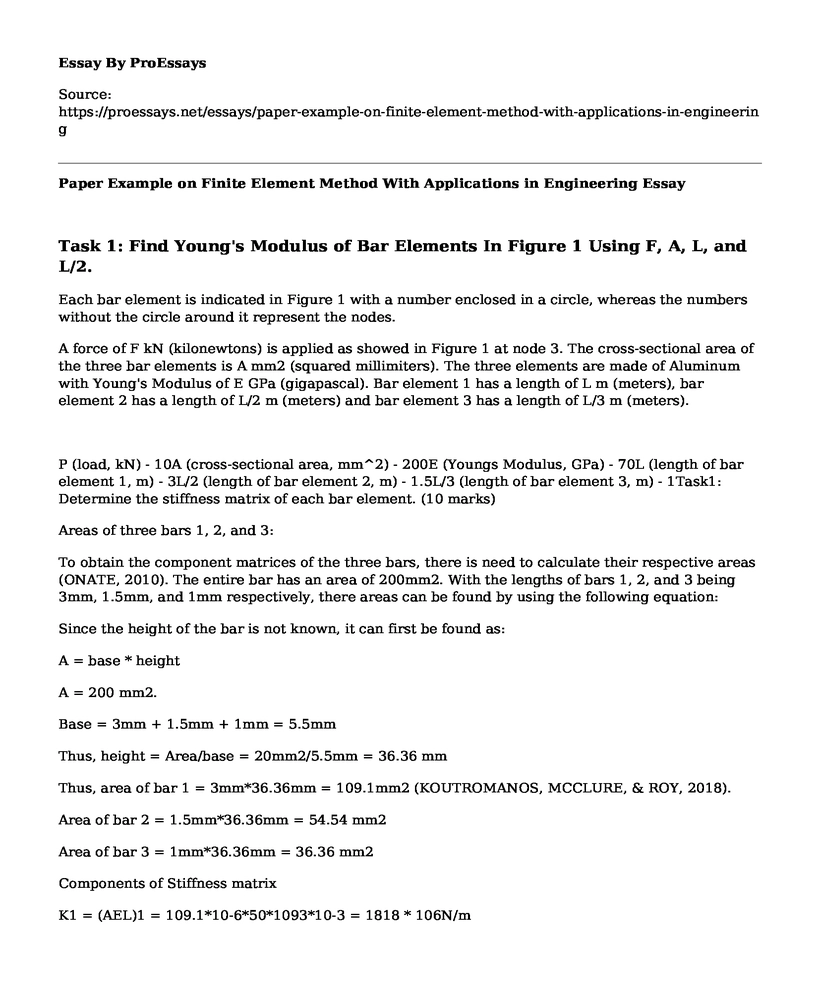Task 1: Find Young's Modulus of Bar Elements In Figure 1 Using F, A, L, and L/2.
Each bar element is indicated in Figure 1 with a number enclosed in a circle, whereas the numbers without the circle around it represent the nodes.
A force of F kN (kilonewtons) is applied as showed in Figure 1 at node 3. The cross-sectional area of the three bar elements is A mm2 (squared millimiters). The three elements are made of Aluminum with Young's Modulus of E GPa (gigapascal). Bar element 1 has a length of L m (meters), bar element 2 has a length of L/2 m (meters) and bar element 3 has a length of L/3 m (meters).
P (load, kN) - 10A (cross-sectional area, mm^2) - 200E (Youngs Modulus, GPa) - 70L (length of bar element 1, m) - 3L/2 (length of bar element 2, m) - 1.5L/3 (length of bar element 3, m) - 1Task1: Determine the stiffness matrix of each bar element. (10 marks)
Areas of three bars 1, 2, and 3:
To obtain the component matrices of the three bars, there is need to calculate their respective areas (ONATE, 2010). The entire bar has an area of 200mm2. With the lengths of bars 1, 2, and 3 being 3mm, 1.5mm, and 1mm respectively, there areas can be found by using the following equation:
Since the height of the bar is not known, it can first be found as:
A = base * height
A = 200 mm2.
Base = 3mm + 1.5mm + 1mm = 5.5mm
Thus, height = Area/base = 20mm2/5.5mm = 36.36 mm
Thus, area of bar 1 = 3mm*36.36mm = 109.1mm2 (KOUTROMANOS, MCCLURE, & ROY, 2018).
Area of bar 2 = 1.5mm*36.36mm = 54.54 mm2
Area of bar 3 = 1mm*36.36mm = 36.36 mm2
Components of Stiffness matrixK1 = (AEL)1 = 109.1*10-6*50*1093*10-3 = 1818 * 106N/m
K2 = (AEL)2 = 54.54*10-6*50*1091.5*10-3 = 1818 * 106N/m
K3 = (AEL)3 = 36.36*10-6*50*1091*10-3 = 1818 * 106N/m
Task 2: Determine the overall stiffness matrix of the structure in Figure 1. (20 marks)
The formula for the overall stiffness matrix is:
[K] =
= 106
In the above entire stiffness matrix, it can be observed that 1 is zero. It is at the point fixed to the vertical structure and where the applied force diverges from. Thus, deleting the first row and column, we remain with the matrix:
= 106
Task 3: Determine the force-deformation relationship for the overall structure in Figure 1. (10 marks)
Force Deformation Relationship:
Assuming the total forces applied to the nodes 1, 2, 3, and 4, as F1, F2, F3, and F4, such that they force each node in the direction of the applied force, then the forces in each node would be:
F1 = (f1)1, F2 = (f2)1 + (f2)2, F3 = (f3)3 + (f3)4,
Expressing them in the matrix equations would form:
= =
= 106
There is the deletion of the first row and the first column of the stiffness matrix since = 0, with the result being:
[k] =106
= 106
Task 4: Calculate the nodal displacements of the interfaces between the materials. (30 marks)
We first of all invert the stiffness matrix. Which becomes:
[k-1] = 303* 10-15
Then,
= 303* 10-15 :since F2 = F4 = 0, and F3 = 10 * 103 Newton,
Then, = 303* 10-15
4 = 303* 10-15 {(10*103) * (2*10*103) * (2*10*103)}
4 = 1.212 mm
4 = 1.212 mm > 1.0 mm
The node can hit the wall, posing a problem that needs to be reformulated (DESAI, ELDHO, & SHAH, 2011).
Task 5: Calculate the nodal forces in each bar element (20 marks)
Bar 1
0< X<300 mm
(x) = N1(x)1 + N2 (x)2 , (x) = X2-Xl11 + X-X1l12
(x) = 1l1[(1x1 - 2x2) + (2 - 1)x]
= 1300[(0x300 - 1.212*0) + (1.212 - 0)x] = 4.04 * 10-3x
Bar 2
300< X<450 mm
(x) = N1(x)2 + N2 (x)3 , (x) = X3-Xl22 + X-X2l23
(x) = 1l2[(2x3 - 3x2) + (3 - 2)x]
= 1150[(1.212*450 - 1.428*300) + (1.428 - 1.212)x] = 0.78 + * 0.216x
Bar 3
450< X<550
(x) = N1(x)3 + N2 (x)4 , (x) = X3-Xl33 + X-X4l34
(x) = 1l3[(3x3 - 4x4) + (4 - 3)x]
= 1100[(1.428x550 - 1*450) + (1 - 1.428)x] = 3.354 - 0.428x
Task 6: Calculate the stress on each element (20marks)
Stress on element 1
s = (El)1[-1 1] = (50*10^9300*10^-3)1[-1 1] = 0.606 * 10^-3 N/m2
Stress on element 2
s = (El)2[-1 1] = (50*10^9150*10^-3)1[-1 1] = 0.476 * 10^-3 N/m2
Stress on element 3
s = (El)3[-1 1] = (50*10^9100*10^-3)1[-1 1] = 0.923 * 10^-3 N/m2
References
DESAI, Y. M., ELDHO, T. I., & SHAH, A. H. (2011). Finite element method with applications in engineering. http://proquest.safaribooksonline.com/9788131724644.
KOUTROMANOS, I., MCCLURE, J., & ROY, C. J. (2018). Fundamentals of finite element analysis: linear finite element analysis.
ONATE, E. (2010). Structural Analysis with the Finite Element Method: Linear Statics. Dordrecht, Springer Netherlands. https://public.ebookcentral.proquest.com/choice/publicfullrecord.aspx?p=5575186.
Cite this page
Paper Example on Finite Element Method With Applications in Engineering. (2023, May 30). Retrieved from https://proessays.net/essays/paper-example-on-finite-element-method-with-applications-in-engineering
If you are the original author of this essay and no longer wish to have it published on the ProEssays website, please click below to request its removal:
- Report Example on Counterfeit Machinery Components
- What Is the Phone? Essay Example
- Physics on Temperature and Heat Essay
- Paper Example on Engineering Ethics: Professionalism
- Master Degree in Architectural Engineering - Admission Essay
- ARAMCO Strategic Plan Paper Example
- Essay Example on Linus Pauling: Nobel Laureate Who Changed Lives







